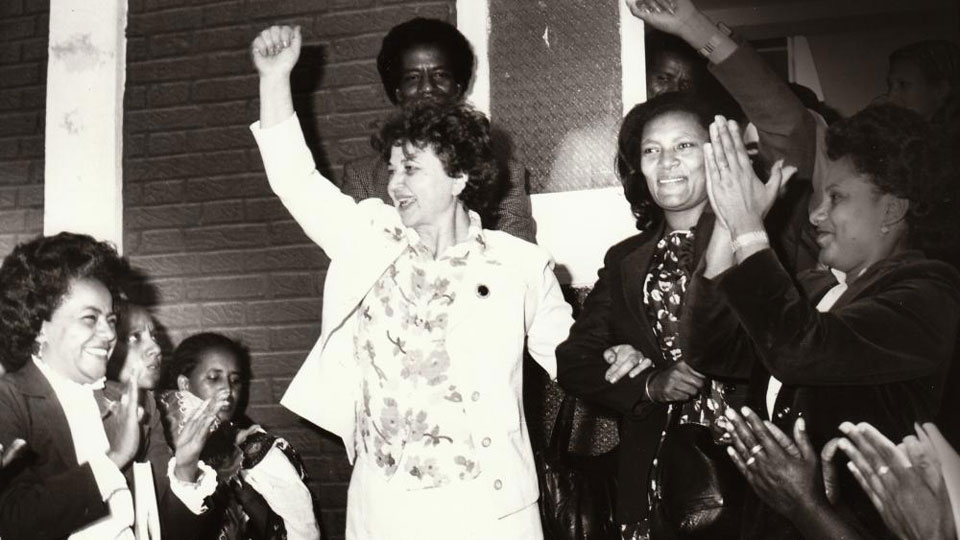
Western, liberal “feminism” often focuses on middle-class women, on expanding individualistic solutions to broader systemic problems, on urging women to “lean in”—in corporate board rooms and in other traditionally male-dominated spaces. Today, this brand of feminism is considered the dominant model in the fight against sexism and for equality.
However, this wasn’t always the case.
In fact, until the early 1990s, global powers contended on a world stage for varying definitions of what was meant by feminism and women’s rights. The First World nations of the capitalist West and the “Second World” nations of the socialist East competed for women’s hearts and minds in the Global South, or the Third World.
Unfortunately, with the collapse of the Soviet Union and the Eastern European socialist states, the struggles that Second and Third World women waged against the narrow confines and individualistic solutions of First World feminism have been largely erased from the historical record.
Thankfully, Kristen Ghodsee has brought this story out of the darkness of obscurity. She has illuminated a global women’s rights movement spearheaded by the socialist East and Cuba. She has brought the alliances formed between the women of the Second and Third World to the foreground. She has accomplished a monumental task with the publication of Second World, Second Sex: Socialist Women’s Activism and Global Solidarity during the Cold War.
Ghodsee, the author of Why Women Have Better Sex Under Socialism: And Other Arguments for Economic Independence, is also Professor of Russian and East European Studies at the University of Pennsylvania.
Contrary to popular notions depicting state socialism as dull and gray, through extensive archival research, interviews, and correspondence, Ghodsee has uncovered a vibrant, militant, dynamic global movement led by women’s organizations in Eastern Europe and their partners in the decolonizing world of Africa and Asia.
Specifically, Ghodsee’s analysis in Second World, Second Sex is focused on socialist Bulgaria and independent Zambia.
She traces leading women’s organizations in these two very different nations as they articulated, fought for, and often won concessions on the national and global stage. She highlights the UN’s International Women’s Year (1975), the First World Conference on Women, and the subsequent Decade for Women (1975-1985). She convincingly argues that the gains made by state socialist women’s organizations shifted the political terrain dramatically to the left to the benefit of women throughout the world.
As Ghodsee notes, during “the Cold War, the West had to deal with the international perception that state socialist countries were the only champions” of women’s rights, a perception backed by the considerable contributions socialist states made in the struggle for equality not only within their geographical borders but in the Global South as well.
“At the United Nations, the Soviet Union and its allies often accused the capitalist West of failing to improve the lives of women, youth, workers, and racial minorities, accusations that forced attention to marginalized groups and proved productive” in the struggles for social and economic justice.
In short, the world’s workers in general—and women in particular—benefited from the “ideological tension” created by state socialism and its allies in the Third World.
According to Ghodsee, “The socialists believed that women’s equality with men required some form of state intervention and necessitated a structural change in an economic system that devalued reproductive labor and care work. They believed that rights extended to women within a fundamentally unjust system would benefit only a minority of women and could too easily be taken away.”
She adds, “Despite failing to live up to all of their promises, Marxist-Leninist parties, wherever revolutionary governments came to power, granted women full legal equality, expanded literacy campaigns, promoted education and professional training, and encouraged full labor force participation.” The Second Word’s “ideological commitments to women’s emancipation and the state’s empowerment of women’s organizations” made these gains and others possible.
This “ideological commitment” was international. For example, “Zambia established diplomatic ties with the Soviet Union and the East European countries soon after independence,” which resulted in “trade, aid, and cultural cooperation” that benefited women. Zambia “received $15 million in direct aid from the Soviet Union and $60 million from the East European countries between 1964 and 1979, and hundreds of Zambian youth were sent to the Eastern Bloc for education and training.” Socialist nations sent educators and trainers to Zambia as well. 
Ghodsee doesn’t gloss over the challenges women in socialist societies faced or the disparities they encountered when hosting international guests. The Committee of the Bulgarian Women’s Movement (CBWM), for example, which hosted women leaders from Angola, Congo, Ethiopia, Ghana, and other de-colonizing or newly independent nations, sometimes resented “that some African women had access to goods that were difficult to attain in the Eastern Bloc…. Since many African delegates were the wives, sisters, or daughters of African leaders, they were also much wealthier than their Bulgarian counterparts.”
While all women in socialist countries benefited from universal health care, generous maternity leave, collective daycare and child-care centers, educational and vocational training, and pay equity, they also had difficulty getting consumer goods and certain feminine hygiene products.
However, by arguing for state intervention on behalf of women’s rights, Second World women, their governments—the socialist East—and their allies in the Third World, forced concessions from the First World—the capitalist West—which benefited women throughout the world.
With the collapse of the Soviet Union and the Eastern European states, as well as the ascension of the far-right globally, Ghodsee’s analysis is needed now more than ever. Second World, Second Sex is a must read for anyone hoping to understand the complexities of a global women’s rights movement that goes beyond the boundaries of Western, liberal feminism.
Second World, Second Sex: Socialist Women’s Activism and Global Solidarity during the Cold War
By Kristen Ghodsee,
Duke University Press, 2019, 306 p.








